

REAL ESTATE MARKET REPORT
RHINE-NECKAR 2025
Office market | Retail | Commercial | Investment market
In focus: Return-to-Office-Analysis Rhine-Neckar
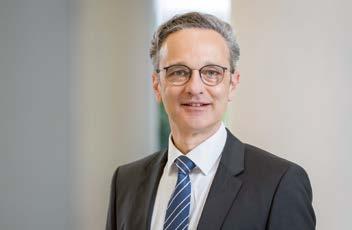
Dear readers,
2025 is all about resilience and transformation for us in the Rhine-Neckar metropolitan region. The current challenges – be it climate change, geopolitical uncertainties or technological progress – require bold and sustainable responses. Our region is meeting these challenges with innovative strength and cooperation. Whether as a hydrogen model region, with energy-efficient construction projects or through climate-friendly neighborhoods – we are setting clear signals for sustainable development.
A central theme of this year’s report is office working hours and their significance for the real estate market. Global trends such as hybrid working models, flexible space concepts and the desire for sustainable solutions are shaping the changing world of work. In our focus topic, we shed light on how companies are responding to these challenges locally and what opportunities are arising for investors. Modern office spaces have long been more than just workspaces – they are becoming places of encounter, innovation and change. The results show: The Rhine-Neckar metropolitan region is an attractive business location and also a pioneer for forward-looking real estate solutions. With courage, creativity and a spirit of innovation, we are shaping working environments that meet the requirements of tomorrow. We hope that this real estate market report will provide you with exciting insights and valuable inspiration for your business decisions!

Peter Johann, Managing Director MRN GmbH
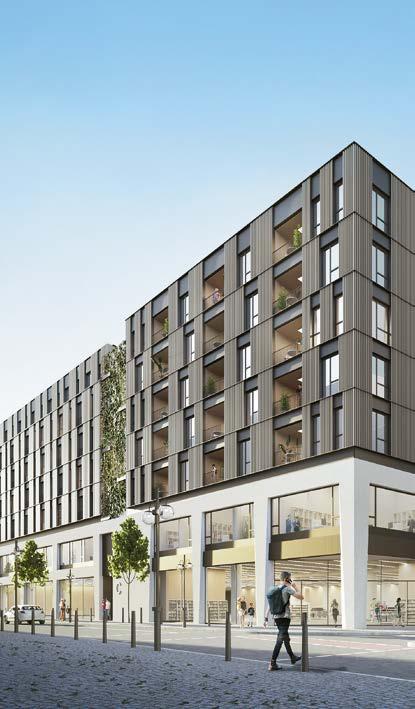

Rhine-Neckar location
The upper floors of NEW7 are realized in sustainable timber hybrid construction.
Office market segment
In Heidelberg, the first construction phase of the BETRIEBSWERK has been completed.

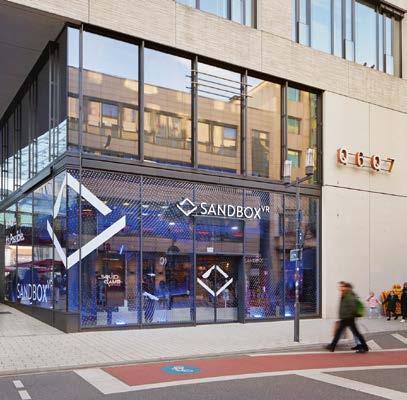
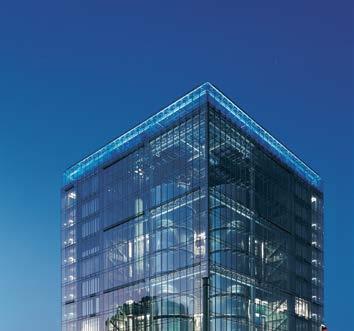
Retail market segment Sandbox offers virtual reality experiences and complements retail in Q6/Q7 in Mannheim.
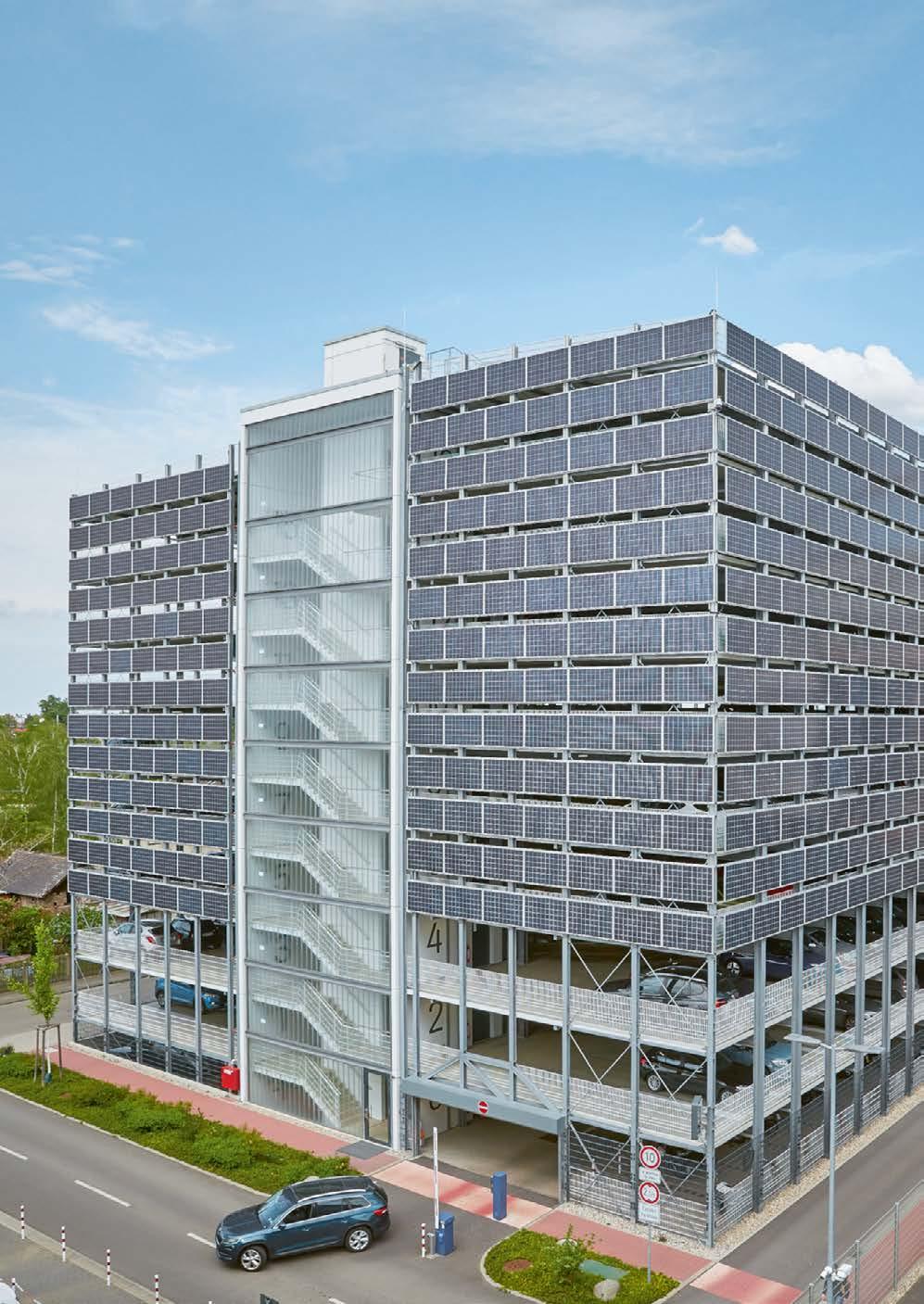
Reliability for a sustainable future
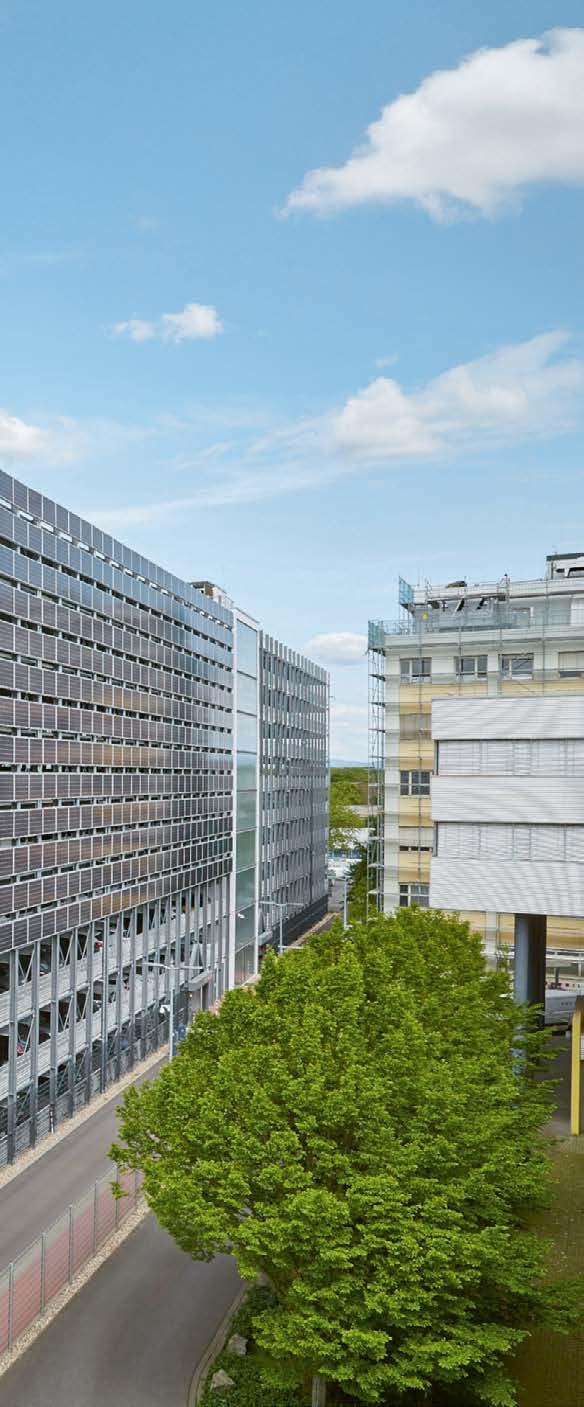
Investments need predictability. The Rhine-Neckar metropolitan region offers this reliability. Here good ideas for a sustainable future can unfold, be it in the field of hydrogen economy, renewable energies or climate-friendly construction.
The future begins in the regions. This is where the solutions for the global challenges of today and the world of tomorrow are developed. However, it is also here that many people ensure that these solutions can develop their benefits for the economy and society. It is often not good ideas that are lacking, but stability and predictability. However, reliability is necessary so that companies, administrations and private individuals can make smart investment decisions and help shape a sustainable future.
The Rhine-Neckar Metropolitan Region (MRN) offers this reliability. Politics and administration, associations and companies are working hard here to enable prosperity and environmental protection. The MRN networks specialist knowledge and know-how, supports technology transfer and encourages civil society involvement. The successes are impressive. For example, the MRN was the first European metropolitan region in Germany to draw up and adopt a voluntary sustainability report (Voluntary Local Review). This report documents the region’s progress in implementing the UN Sus-
Photovoltaic system at the parking garage of Roche’s Mannheim site: With an area of over 1,000 square meters, this is one of the largest vertical systems in Europe.
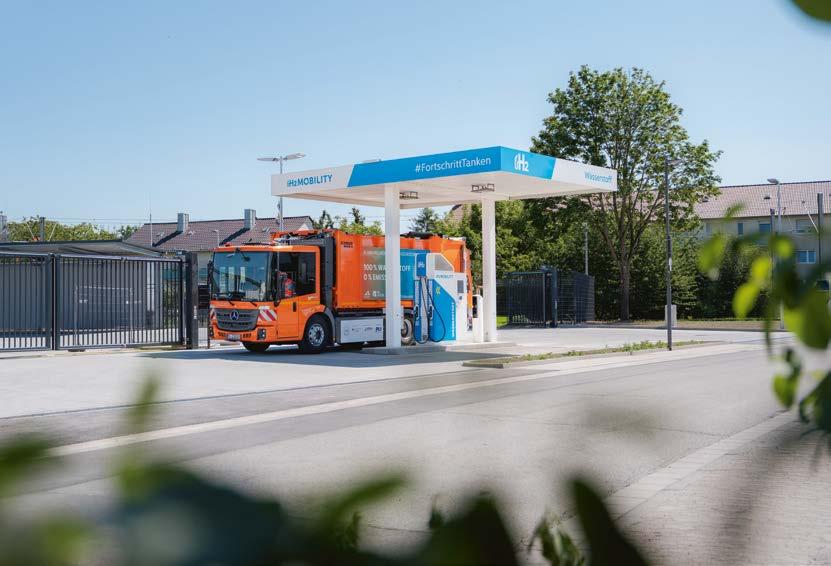
Successful pilot project
With H2Rivers, a comprehensive hydrogen infrastructure has been established, ranging from the production of climate-friendly hydrogen and renewable energies to the installation of new filling stations. In addition, fuel cell technologies have been successfully integrated into public and municipal vehicles to demonstrate market readiness.
tainable Development Goals. The MRN received particular praise for setting up a sustainability monitoring system that can serve as a model for reporting by other municipalities.
Hydrogen as the key to the energy transition
Know-how, networking and commitment are also required for the sustainable restructuring of the energy system. Hydrogen as an energy source can play an important role on the Rhine and Neckar in the future. This is the result of the two MRN demonstration projects H₂Rivers and H₂Rhine-Neckar. They showed how a regional value chain can be established – from the production of hydrogen on site to its distribution via a network of hydrogen filling stations and its use in buses, cars and various commercial vehicles. Further expansion stages of the emerging H₂ ecosystem are to follow soon: BASF plans
Hydrogen is becoming a key technology in the energy transition and is driving climate-friendly change in transportation and industry.
to commission a 54 MW electrolyzer in Ludwigshafen, hydrogen is to be produced on the grounds of sewage treatment plants in Speyer and Landau and hydrogen-powered inland waterway vessels are likely to be on the Rhine in the near future.
Advancing renewable energies through strong partnerships
The importance of partnerships and alliances in these transformation processes can also be seen in the inten-
The new hydrogen filling station on the rnv site in Mannheim opened in October 2024.
Pioneering work
The Rhine-Neckar region was the first European metropolitan region in Germany to draw up, adopt and officially hand over a Voluntary Local Review (VLR) to the United Nations.
sified use of renewable energies. Together with Stadtwerke Frankenthal, BASF is planning a solar park on 100 to 120 hectares that will generate 140,000 megawatt hours (MWh) of electricity per year and contribute to the electrification of the Ludwigshafen site. BASF is not alone in intensifying the use of PV: Daimler installed PV modules at its Wörth plant, which produce around 4,000 MWh of electricity per year. Roche is building one of the largest vertically installed PV systems with an area of over 1,000 square meters in the parking garage at its Mannheim site. By 2026, the company aims to generate around 2,000 MWh of electricity per year with a total of 10,000 modules on site.
In addition to the sun, the MRN in the Rhine Valley has another sustainable energy source that can be used as part of the energy transition: Geothermal energy. Together with the Karlsruhe-based company Vulcan Energy, BASF wants to supply the Ludwigshafen site with CO₂-free steam via deep geothermal energy. The new plant could avoid around 800,000 tons of CO₂ emissions per year. Vulcan
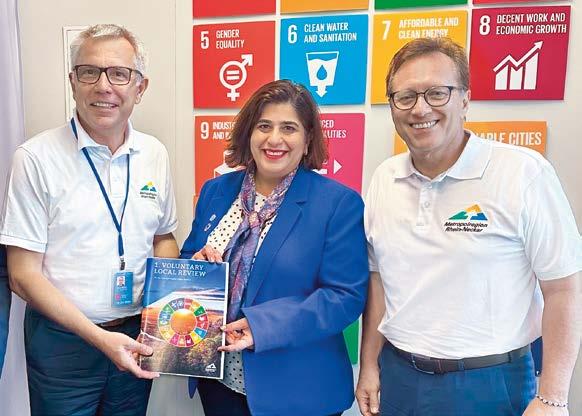
The future of heat supply lies in climate-friendly alternatives such as district heating, large heat pumps and geothermal energy.
Energy then wants to use this steam to extract lithium. BASF and Vulcan are also working with Technische Werke Ludwigshafen and Stadtwerke Frankenthal to find out how deep geothermal energy can be used locally to generate district heating.
New paths in climate-friendly heat supply
The MRN can bring its strengths to bear in the heating sector in particular: The moderation and coordination of networked solutions create reliable framework conditions and thus the basis for viable investment decisions. However, the ability to plan also includes making it clear which energy sources will no longer be available and when. In November 2024, Mannheim-based supplier MVV announced that it would be decommissioning its gas grid by 2035. The background: MVV AG has committed to becoming not only climate-neutral but also climate-positive by 2040. The company will therefore no longer transport and use natural gas in the future. Alternatives for the 56,000 households affected would be private heat pumps or a connection to the district heating network.
In addition to geothermal energy, large heat pumps are an option for decarbonizing district heating generation itself. In Heidelberg, plans were initiated in November 2024 for a river heat pump at the Ernst Walz Bridge, which will extract renewable heat from the Neckar and thus ensure a climate-friendly heat supply. From the end of 2027,
Handover of the voluntary sustainability report to the United Nations on July 17, 2024.
a large heat pump on the site of the BASF wastewater treatment plant in Frankenthal will supply 18,000 house connections with heat. Since October 2023, one of the largest European river heat pumps of its kind has been supplying climate-friendly heat for around 3,500 households from the Rhine water on the site of Großkraftwerk Mannheim AG (GKM). With its thermal output of 20 MW, the plant saves 10,000 tons of CO₂ per year, according to MVV. By 2030, the company aims to generate all of its district heating from climate-friendly sources. In addition to Mannheim, the neighboring municipalities of Heidelberg, Schwetzingen, Brühl, Ketsch and Speyer will also benefit from this.
Sustainable construction and the circular economy as a model for the future
The challenge of reducing CO₂ emissions also affects the construction industry. In the MRN, numerous initiatives and projects are helping to achieve the EU target of reducing greenhouse gas emissions in the construction sector by around 80 percent by 2050. The regional circular economy offers good opportunities. In Heidelberg, the “Circular City Heidelberg” pilot project has already been launched on the city’s largest conversion site, the Patrick Henry Village. The materials generated during the development of the new district are to be reused rather than landfilled wherever possible. Building with wood opens up further perspectives. In Mannheim, the New7 project shows how this can be done: On the basis of the old department store in N7, a timber hybrid building is being erected from the second floor upwards. Heidelberg Materials proves that concrete can also be more climate-friendly: the company has developed the world’s first cement with a net-zero footprint. The highlight: the underlying process efficiently separates the CO₂ generated during the production of lime and cement.
“Climate-friendly construction and renovation” was also the main theme of Expo Real, Europe’s most important trade fair for real estate and investment, which took place in Munich in October 2024. The MRN presented its networking activities in this area on site and provided information about its support services for realizing future-proof construction projects. In addition to local authorities and economic development agencies, project developers, construction and real estate companies, investors and financiers as well as architects from the region were represented at a joint stand. Visitors were able to gain practical information and learn about the full range of investment and funding opportunities in the MRN. In March 2025, the MRN will then be represented at the MIPIM commercial real estate trade fair in Cannes in the south of France to promote the location to potential investors. As a reliable partner that ensures that a sustainable future can flourish in the region.
Rhine-Neckar real estate network
The network aims to connect stakeholders, discuss current topics and convince investors with its event formats of real estate dialogues, partner meetings, annual receptions and summer tours for journalists: www.m-r-n.com/ immobiliennetzwerk
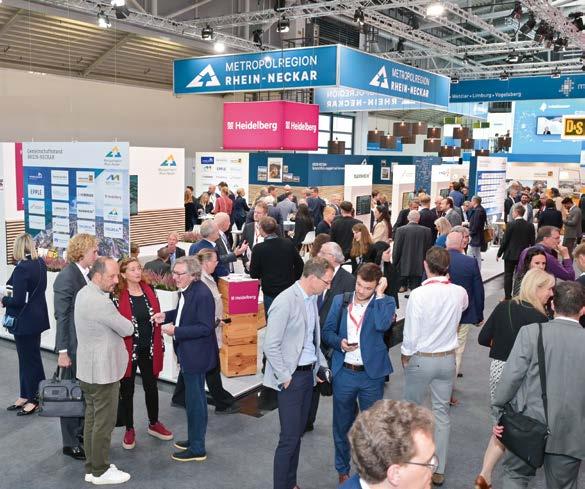
At a glance
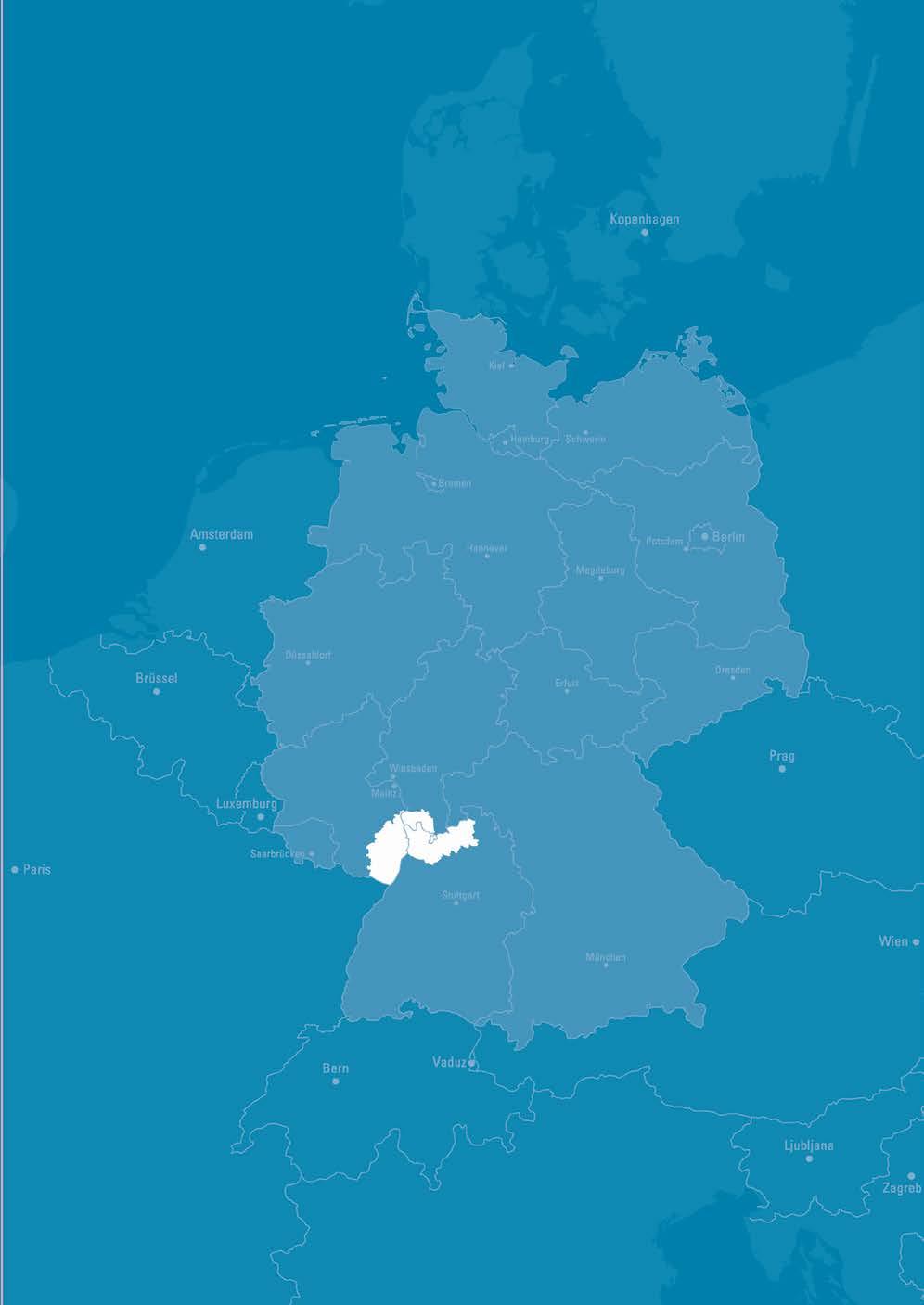
Strategic growth areas
• Hydrogen model region
• Renewable energies
• Life sciences & health
• Digitalization & AI
Strong and dynamic business location
• 160,000 companies
• 984,000 employees subject to social insurance contributions
• 95 billion euros gross value added
• 9 listed companies with a market capitalization of 257.5 billion euros, 3 of which are DAX-listed
Population and area
• 2.4 million inhabitants
• 5,600 square kilometers
• 15 urban and rural districts
• across three federal states
Education and research
• 30 internationally recognized research institutes
• 22 universities
• Approx. 90,000 students
• 16 Nobel Prize winners
Infrastructure and accessibility
• 8 freeways
• 22 kilometers of high-speed cycle path
• 240 long-distance departures per day from Mannheim main station:
0 h 30 to Frankfurt Airport
3 h 00 to Paris Gare de l’Est
2 h 43 to Munich main station
Real estate market
• 4.3 million square meters of office space
• 160,000 square meters of office space turnover
• 597 million euros total investment volume
Investment volume increases again after a dry spell
Once the bottom has been reached, things start to pick up again. The investment market in the Rhine-Neckar metropolitan region backs up this truism with concrete figures. And for the first time, retail is replacing the office segment.
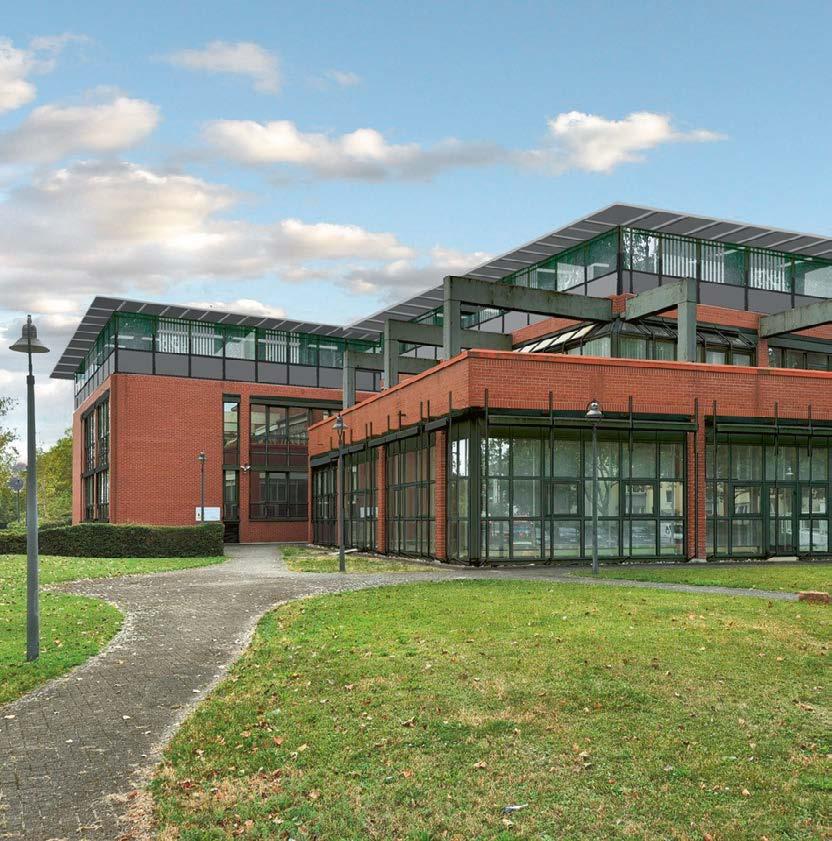
Dentists’ building in ludwigshafen – hensel Immobilien takes over the office bulding at Brunhildenstrasse 1 (3,400 square meters total area on 6,000 square meters plot), built in 1981, and plans to modernize it and add another storey.
The record years of 2020 and 2021, with transaction volumes of around 1.3 and 1.25 billion euros respectively, experienced an abrupt downturn in the coronavirus year of 2022, which became even more pronounced in 2023. At around 647 million euros, turnover halved in 2022 as the world and the region battled the virus; one year later, the low point was reached at 556 million euros, with rising interest rates having an additional impact on the market alongside Covid.
2024 also fell short of the five-year average of more than 872 million, but the transaction volume of more than 597 million euros shows an initial trend in the right direction with an increase of more than seven percent compared to the previous year. And for the first time, retail overtook the office segment with 38.5 percent, which came in third place in the metropolitan region with 23 percent in 2024 – behind the diverse mix of “other”, which includes residential properties. The “warehouse and logistics” segment also suffered a massive slump, falling from 26.8 percent in 2023 to 3.6 percent in the following year.
Spectacular investments
The acquisition of the Print Media Academy (PMA) in Heidelberg’s Kurfürstenanlage, which the local KRAUSGRUPPE bought from a Luxembourg fund company, was one of the most spectacular investments in the region in 2024. Real estate
The silver lining on the horizon of regional investment may be narrow, but it cannot be overlooked.
entrepreneur Hans-Jörg Kraus will renovate the 50-meter-high glass cube, which cost 80 million German marks at the time and was inaugurated in April 2000, in such a way that up to 90 percent of the previous energy requirements can be saved.
Investments in the Rhine-Neckar region
In cooperation with Bulwiengesa, 36 transactions were identified for the Rhine-Neckar region. The volumes are partly based on estimates.
Kraus plans to invest up to 25 million euros in the conversion of the PMA and revitalize the approximately 10,000 square meters of rental space with conference areas, offices and restaurants; the building is scheduled to open in the first quarter of 2027.
The sale of a deep hole in Ludwigshafen also caused a positive stir. For ten years, the excavation pit, dug by Ettlingen-based TIMON Bauregie before its insolvency, was one of the biggest annoyances in the city center. The commercial real estate project “Metropol”, which was to be built on Berliner Platz, was a waste of time after the company filed for insolvency in July 2022, until the Freiburg-based Unmüssig Bauträgergesellschaft Baden acquired the 2,800 square meters of land in 2024. Together with architect Prof. Max Dudler, Unmüssig plans to replace the previously planned 19-storey Metropol high-rise with a five to seven-storey office and commercial building that will blend in with the urban surroundings. Construction of the project, which will cost around 60 million euros and is to be realized under the name “Palatineo”, is scheduled to begin in early 2026.
Following the bankruptcy of the Benko empire and the associated insolvency of Signa Holding, the future of the Galeria Karstadt Kaufhof property on Mannheim’s Paradeplatz was the focus of local public interest. The local Boxheimer und Scheuermann GmbH took over the property with 14,000 square meters of rental space and thus obtained a shopping magnet in the city of squares.
Gloram Real Estate is planning further investments in the Darmstädter Hof Centrum (DHC) in Heidelberg. The mixed-use building ensemble on Hauptstrasse has 27,000 square meters of rental space. In addition to 100 apartments, tenants include retailers, medical practices, offices and schools. The new tenants include a REWE supermarket, and a fitness studio from the Fitseveneleven chain will move in next year.
Selected transactions 2024
From 2026, the Palatineo with stores, restaurants, cafés and offices will emerge from the tenyear nuisance known as the construction pit on Berliner Platz.
The Mannheim-based company Hensel Immobilien has acquired a vacant Brunhildenstrasse office building in Ludwigshafen via a property company; the seller was the Rhineland-Palatinate Association of Statutory Health Insurance Dentists. The building stands on a 6,000 square meter plot and offers around 3,400 square meters of total space on three floors. The building, which
Q4
Grundstück Berliner Platz Ludwigshafen Q4
Timon-Gruppe
Unmüssig Bauträgergesellschaft Baden mbH –Zahnärztehaus Ludwigshafen Q4
Kassenzahnärztliche Vereinigung Rheinland-Pfalz
Projekt- und Grundstücksentwicklungsgesellschaft mbH
Karstadt Kaufhof P1
Q3
C&A im RNZ Viernheim Q4
Sportarena Heidelberg Q3
Am Ochsenplatz 17 Worms Q1
Residential Sullivan Baufeld D5 –Neubauwohnungen in serieller Holzhybridbauweise
Baufeld D7.2 –Neubauwohnungen in serieller Holzhybridbauweise
Wohnen am Wasser –Joy am Ufer II
Hospital – 3 Baufelder Deutsche Wohnwerte
Mannheim Q2 Gateway Real
markt 4,652
Wohnwerte GmbH
Grundstück Boehringerstraße Mannheim Q3 Stadt Mannheim Lipp Mischtechnik GmbH –Hotel Ibis Budget Mannheim
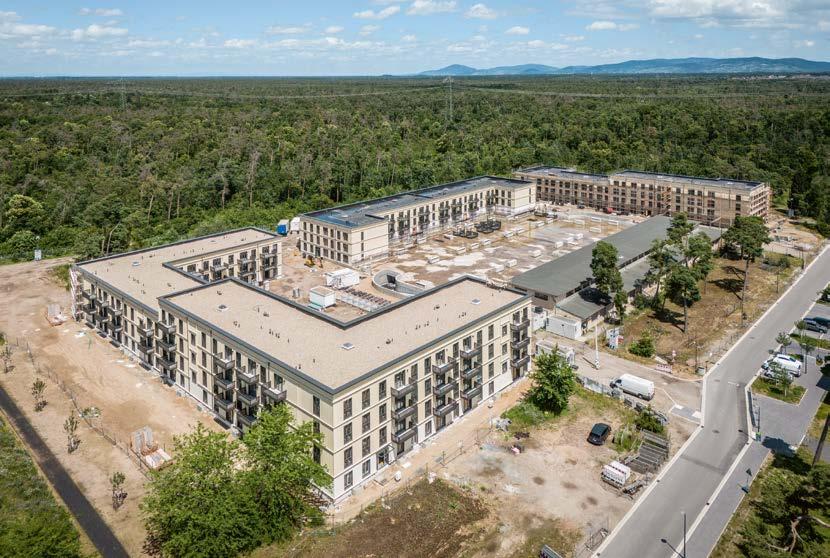
dates back to 1981, is to be modernized and an additional storey added.
New housing on the conversion sites
GBG has expanded its housing stock on the former FRANKLIN conversion site by acquiring 361 new-build residential units on the north-eastern SULLIVAN sub-area – 352 of which are subsidized via the state housing subsidy. The predominantly two- to four-room apartments are rented
361 residential units on the FRANKLIN | Sullivan conversion site mean second place for the Other segment, which also includes the residential sector.
out at a cost price of 8.90 euros per square meter, which is 40 percent below the local comparative rent; rent increases are limited and the commitment period is 40 years. The buildings were
constructed according to the KfW40 standard in serial timber hybrid construction and have two underground garages with a parking space factor of 0.8. The location with its proximity to the Käfertal forest, adjacent open spaces and the terminus of the new Franklin light rail make living on the conversion site attractive.
Deutsche Wohnwerte sold a residential project to the Hopp family office as part of a forward deal. In two L-shaped building blocks in the Rohrbach district, 71 residential units will be built, 24 of which will be socially subsidized. In addition, 66 car and 140 bicycle parking spaces will be created. The project is based on a design by Munich architects Dietrich Untertrifaller Architekten and construction is scheduled to start next year. It is one of three construction projects on the Hospital conversion site, which used to be home to a US Army hospital, among other things. There are plans for 600 apartments, a student residence and areas for local amenities, commerce and education on the entire site.
GBG expands its residential portfolio – 361 new-build apartments in serial timber hybrid construction on Sullivan (FRanklin , construction sites D5 & D7.2)
New high for take-up and prime rents
in 2024, the region’s office markets developed promisingly overall, with a significant increase in take-up. The picture for completions and vacancies was mixed in the three regional centers.
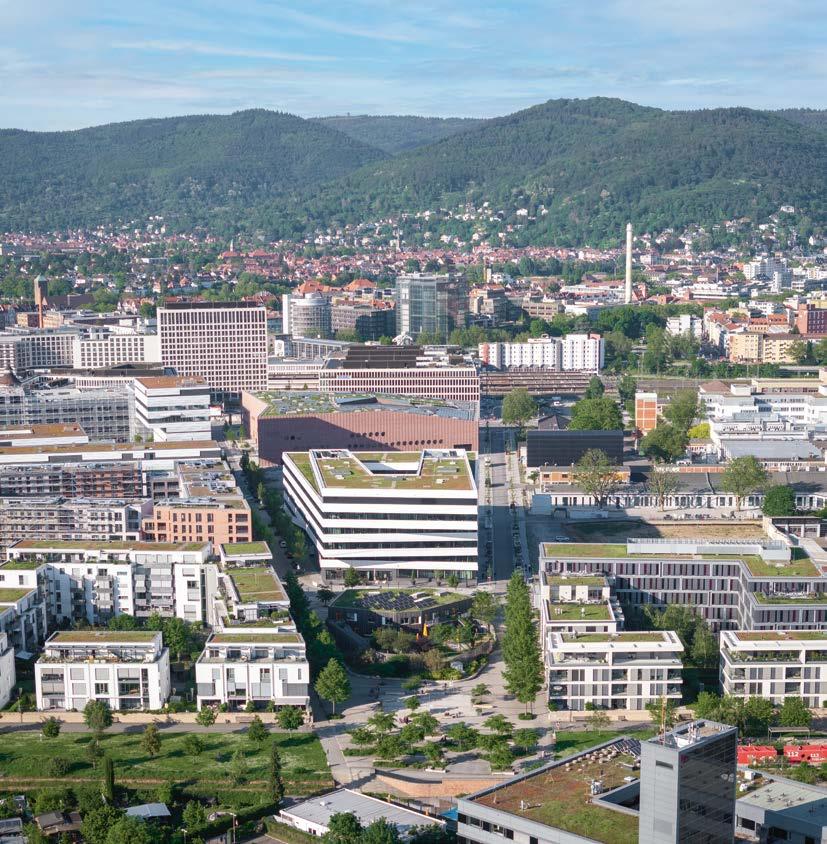
Heidelberg’s Bahnstadt with Sky Angel (white) in the foreground and Congress Center, Europaplatz and Atlantic Hotel in the background – projects that stand for sustainable urban development, modern architecture and economic impetus.
The office real estate market in Germany was stable overall in 2024. Lettable office space amounted to around 200 million square meters, with a vacancy rate of 5–6 percent in major cities and 7–12 percent in less sought-after locations. Prime rents for high-quality office space rose by 2–4 percent in the Big 7 cities and were between 25 and 40 euros per square meter. In B locations, rents were around 12–18 euros per square meter. Construction activity was moderate, with around 1.5 million square meters completed. The investment volume amounted to around 10–12 billion euros, with 60–70 percent being accounted for by Big 7 cities and sustainable office buildings. Around 30–40 percent of new buildings had sustainability certification. The trend towards hybrid working models was reflected in the average office space per employee, which fell to around 10–12 square meters.
In the Rhine-Neckar metropolitan region, takeup increased by 54 percent compared to 2023. The letting result in Mannheim, Heidelberg and Ludwigshafen exceeded the five-year average and reached 160,600 square meters. Mannheim recorded the highest take-up with 65,200 square meters, followed by Ludwigshafen with 49,200 square meters and Heidelberg with 46,200 square meters. The region benefited from growing construction activity and modern new builds that met market requirements for sustainability and flexibility. Rents remained moderate compared to large metropolitan areas, making the region attractive to investors and companies. Prime rents in Mannheim remained stable for the second year in a row at 22 euros per square meter, while prime rents in Heidelberg (19 euros per square meter) and Ludwigshafen (16 euros per square meter) rose by one euro each.
Mannheim: High vacancy rate and lower average rent despite stable prime rent Mannheim, traditionally the strongest office center in the region, recorded a slight decline in office space take-up despite lively market activity, as the number of larger deals fell. While the prime rent remained stable at 22 euros per square meter, the average rent fell to 14.30 euros per square meter. The vacancy rate rose from 6.3 to 10.9 percent, partly due to ABB (50,000 square meters) and Siemens (26,000 square meters) moving out. The new construction pipeline remains well filled with 44,000 square meters for 2025, but some space from previous years has not yet been let.
Development of completions in 1,000 m²
202420242024 2025*2025*2025 2023* 20232023
MannheimHeidelbergLudwigshafen
Source: gif/own survey
forecasts
Due to the completion of four large properties, the completion volume in Mannheim remains above average at 66,000 square meters for the second year in a row. With its striking black façade, LOKSITE forms a striking landmark at the southern entrance to the Glückstein Quarter. The 12-storey office building offers around 25,000
Hans-Thoma-Strasse has established itself as an attractive office location in Mannheim.
square meters of office space with modern conference and meeting rooms. The property, designed by Lepel & Lepel, was certified according to the BREEAM standard and received the ICONIC AWARD in the Architecture – Corporate category in 2024. After partial areas were already occupied in 2023, the entire building was completed in the first quarter of 2024.
Bauhaus AG’s head office was inaugurated on July 3, 2024. As part of the expansion of the Service Center Germany (SCDE), BAUHAUS invested over 70 million euros in the renovation of the building complex in Gutenbergstrasse. The campus for up to 1,500 employees combines the high-rise building constructed in 2007 with a new five-storey building to KfW40 standard.
DIRINGER & SCHEIDEL realized the extension with 25,000 square meters of gross floor space, while the planning and interior design came from Blocher & Partners.
The ABB Campus in Käfertal comprises 20,000 square meters of office space. On Kallstadter Strasse in Mannheim, ABB constructed a sustainable, technically innovative multifunctional building that promotes modern working methods. The new building offers over 1,200 workstations, supports efficient, productive and customer-oriented working and was completed in 2024.
Siemens Mannheim moved into its new office building in Hans-Thoma-Straße in November 2024. CO₂-neutral operation is ensured by heat pumps, heat exchangers, photovoltaics and renewable energies. The landlord is Adler Immobilien Investment from Viernheim, while Studio SF from Mannheim was responsible for the planning.
Current project developments include the Konradhaus in Dudenstrasse with around 30,000 square meters. The revitalized Dudenstrasse 44 provides flexibly divisible space of around 12,000 square meters, with a modern office standard that also enables the space to be cooled and allows room layouts according to tenant requirements. Most of Dudenstrasse 46 has already been let and is ready for occupation.
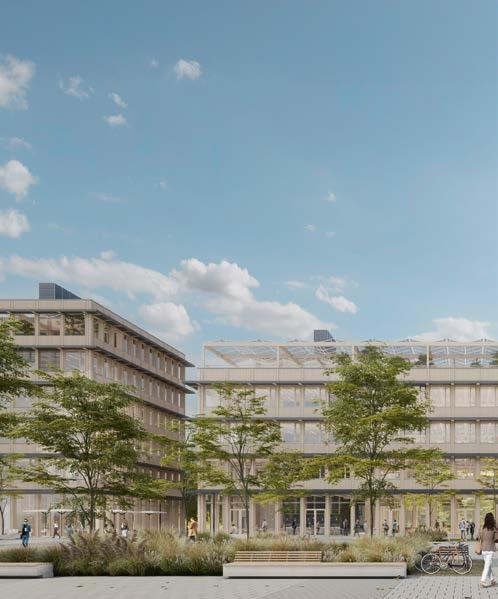
Bau Baden-Württemberg. The building will be modernized in terms of energy efficiency and made barrier-free, including a photovoltaic system and green roof. The energy measures are expected to save around 112 tons of CO₂ and energy costs of around 90,000 euros per year. The refurbishment aims to achieve “BNB Silver” certification and will cost around 47 million euros, with completion scheduled for 2025.
The well thought-out mix in the quarter makes Bahnstadt a sought-after office location in Heidelberg.
The GREENSITE office building in Hans-ThomaStrasse offers a total of 6,500 square meters of office space with flexible room layouts and is almost fully let. Features include geothermal energy, a photovoltaic system, building component temperature control, a ventilation system and electric car charging stations.
The refurbishment of the tax office in L3 is being planned by Schmucker und Partner, with project management by Landesbetrieb Vermögen und
Aurelis Real Estate Service GmbH is planning two further large office properties in the Turbinenwerk: Haus Lilienthal and Haus Galvani.
Heidelberg: Increase in take-up, completions and prime rent
Heidelberg showed dynamic development with a 67.9 percent increase in total take-up to 46,200 square meters. Take-up by tenants grew by 55.6 percent, while take-up by owner-occupiers increased fivefold. The prime rent climbed to 19 euros per square meter, while the average rent rose to 14.70 euros per square meter. The volume of completions was also above average at around 45,000 square meters. The vacancy rate rose to 5.1 percent at the end of 2024 (4.0 percent in 2023). In 2025, only 6,000 square meters of office space is expected to be completed in two office building projects.
Hitachi Columbus Campus in Mannheim –a pioneering construction project that combines modern working environments with sustainable architecture and underlines Mannheim’s importance as an innovative business location.
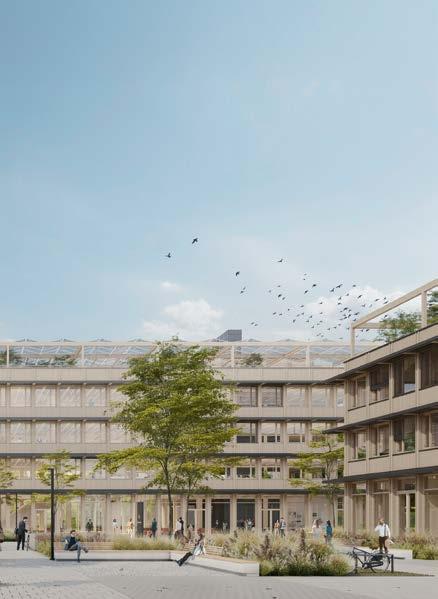
The high completion volume is due to the quarter developed by the Gustav Zech Foundation around Europaplatz at the southern entrance to the main railway station. The Kopernikusquartier C4 was also completed in Bahnstadt in the fall of 2024. It was realized by Kreer Development GmbH as a modern office and residential ensemble. The office building offers 6,900 square meters of rental space, of which 5,850 square meters are office space and 1,050 square meters are retail, commercial and restaurant space. Two residential buildings with a total of 108 two-, three- and four-bedroom apartments with a gross floor area of 10,400 square meters are located on the southern part of the site. Of this, 25 percent is subsidized housing.
Four larger projects are currently under construction or renovation. These include SkyOne, which is designed as an integral part of an urban research and working environment and will serve as the new headquarters of Ascendis Pharma in future. Construction of the multifunctional laboratory and office building is scheduled for completion in 2025. A gross floor area of 13,711 square meters above ground will be built on a plot of 4,717 square meters. Werkstatt Fischer Architekten and the construction companies A. Altenbach and Bau Streib are involved in the project.
Key office market figures in Mannheim
Indicators
Key office market figures in Heidelberg
Indicators 2024 2023 2022
Key office market figures in Ludwigshafen*
Indicators
Existing
* In Ludwigshafen, the indicators city fringe and periphery cannot be determined due to an insufficient database of financial statements.
Source: gif/own survey
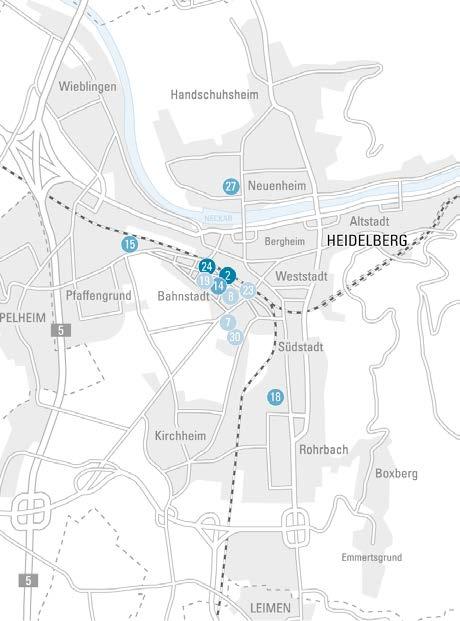
A new building complex for the German Cancer Research Center (DKFZ), which will house the national cancer prevention center, the Schadeberg Center for Digital Oncology and Disruptive Technologies and basic research, has been under construction on Berliner Strasse in Heidelberg since June 2024. The building complex with a gross floor area of 24,000 square meters offers a flexible space concept with open-plan office areas, laboratory modules and areas for special functions. The building will be certified to the silver standard of the Sustainable Building Rating System and is scheduled for completion by the end of 2026.
At the depot, the first construction phase consisting of the existing buildings of the former workshops has been completed; the sections currently under construction include four workshop buildings and a seven-storey factory tower. On the Campbell site, the existing Torhaus building is currently being renovated and is being prepared by the Kraus Group for use by educational institutions.
The PROXY project by Kolb + Partner in the Heidelberg Innovation Park (hip) is currently being planned. It is based on a sustainable mixed-
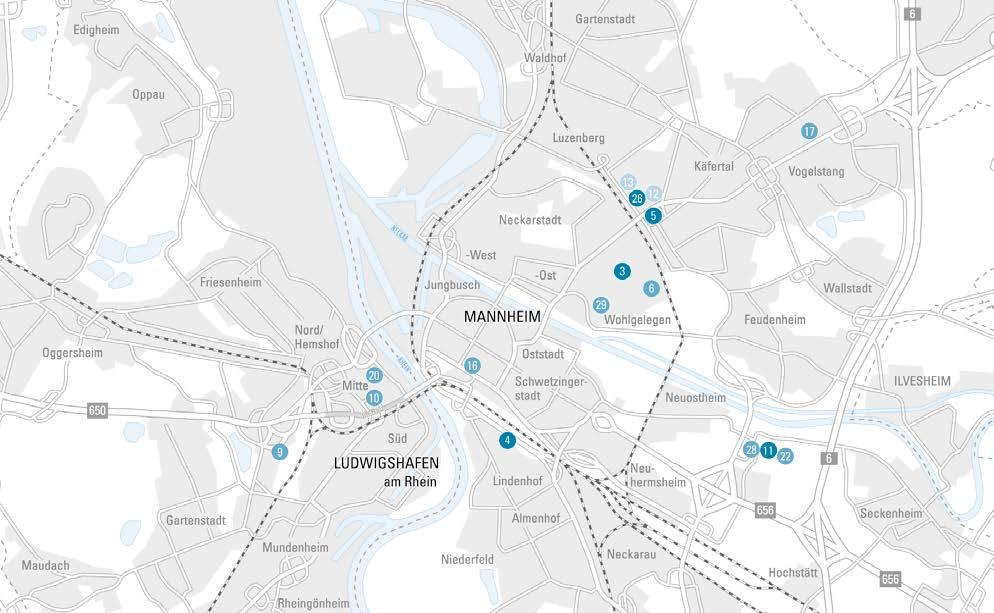
Numerous new office buildings are being built in Heidelberg, Ludwigshafen and Mannheim, the locations of which can be seen on the two maps. Further information on the projects can be found in the table on page 21.
use concept that combines office, residential and childcare facilities. There are 3,500 square meters of divisible office and service space for rent, spread over the 2nd and 3rd floors of the I-building and the first floor of the L-building. In addition, a high-quality boarding house is planned to cover the need for temporary living space. The
In
Ludwigshafen, the office market is dominated by three major projects.
quarter also has a modern daycare center with spacious outdoor areas that can accommodate up to 150 children.
The planned SunYard project in Bahnstadt combines innovative architecture and sustainable building concepts. The space concept comprises 8,200 square meters of office space on three to five floors as well as 1,500 square meters for retail and gastronomy on a 4,200 square meter site and complies with the DGNB Gold standard. Strabag Real Estate is responsible for the project. Completion is scheduled for 2027.
Ludwigshafen: Surprising record takeup, but hardly any space available Ludwigshafen recorded the highest increase in take-up and, driven by several owner-occupier deals, set a record of 49,200 square meters. This result is well above the five-year average of 13,500 square meters. Two deals exceeded the 10,000 square meter mark: The City of Ludwigshafen rented 16,400 square meters in the Ludwig Towers, while the start of construction of the police headquarters in Heinigstrasse accounted for 15,000 square meters. The new IHK Pfalz building with 7,500 square meters also contributed to the high take-up. The prime rent rose to 16 euros per square meter, but with a vacancy rate of just 2.5 percent, there is hardly any available space. The market situation will only ease in the coming years once the large properties completed in 2024 are occupied; there are no further projects in the pipeline in the short term.
The city administration of Ludwigshafen is renting the Ludwigstürme, the completely renovated former Postbank building, from the Unmüssig
Group for 20 years. The building will be used as a back office and offers space for 580 modern workstations. The aim of the lease is to consolidate previously dispersed offices and implement the city’s “Workplace of the Future” project. Before moving in in autumn 2027, the building will undergo extensive modernization, including energy-efficient refurbishment, technical upgrades and an office fit-out in line with city specifications.
The new police headquarters in Heinigstraße replaces the old headquarters in Ludwigshafen-Süd. The new two-tower building provides space for 650 police officers and administrative staff. It will cost around 141 million euros and should be ready for occupancy at the end of 2027. Under the management of the Landesbetrieb Liegenschafts- und Baubetreuung (LBB), three basement levels are being built – including an underground garage with 141 parking spaces – as well as two building sections: a 12-storey section facing Heinigstrasse and Wredestrasse and an 8-storey section facing Bürgermeister-Hoffmann-Strasse.
The “Haus der Wirtschaft”, the new headquarters of the Chamber of Industry and Commerce (IHK) on Ludwigsplatz, is being built by a joint venture between Schifferstadt-based Heberger Hoch-, Tief- und Ingenieurbau GmbH and Implenia Hochbau GmbH. Completion is planned for mid-2026.

Projects and spaces for investors and companies
The Rhine-Neckar metropolitan region offers numerous locational advantages, above all its central location in Europe, an efficient, multimodal infrastructure and well-developed commercial areas for new companies and expansion. For example, the mannheim turbine plant – the 20-hectare site is a place with a vibrant industrial history that offers plenty of room for the future.
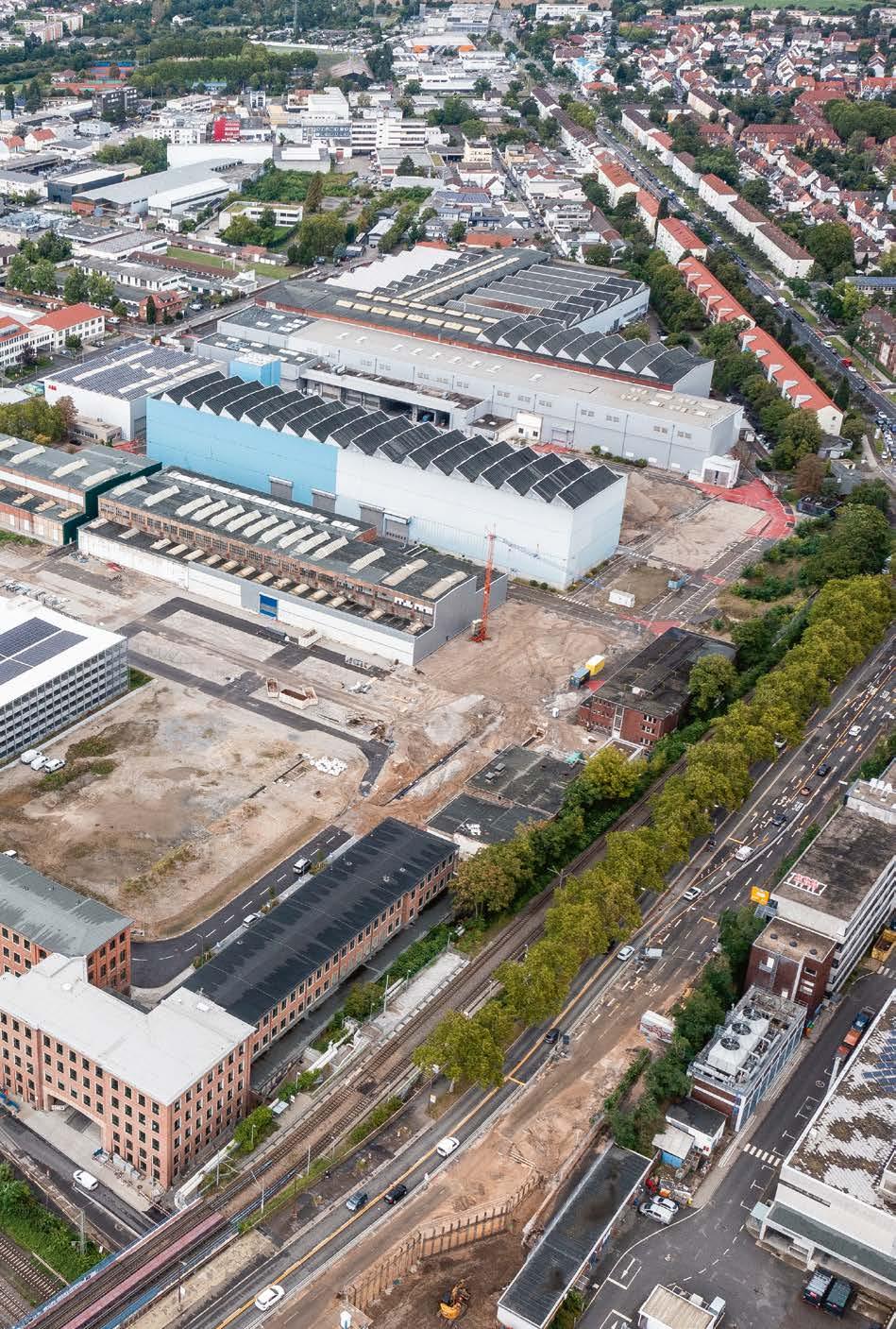
The most important project developments in the Rhine-Neckar region
Current office projects at a glance
SkyOne
Bauabschnitt 2+3
Numerous new office buildings are being built in Heidelberg, Ludwigshafen and Mannheim, the locations of which can be seen on the two maps on page 18. in planning under construction completed
und Handelskammer Pfalz
Selected investments in production and logistics properties
Odenwald – IGO
Lampertheim Wormser Landstraße II
7 Heidelberg Bahnstadt
8 Groß-Rohrheim Am Entenweg II
Sustainable strategies provide strong impetus
The Rhine-Neckar metropolitan region remains a sought-after location for commercial investments. The high demand for logistics and production space meets targeted location developments that enable further growth.
The German investment market for commercial real estate as a whole achieved a turnover of around 25 billion euros in 2024. This marked the start of a national market recovery, with the previous year’s figures being exceeded by around 15 percent, mainly due to a strong fourth quarter. In the Rhine-Neckar metropolitan region, the increase in the fourth quarter failed to materialize and the “warehousing and logistics” asset class experienced a historically poor year with an investment volume of only around 22 million euros and a market share of 3.6 percent. A normalization is expected in 2025, as the region with the regional centers of Mannheim, Ludwigshafen and Heidelberg remains attractive for investments in production and logistics properties due to its strategically favourable location and excellent transport connections.
In 2024, 25 selected industrial estates with a total area of around 4.1 million square meters were analysed in an annual survey of local authorities. Of this, almost 900,000 square meters of undeveloped space is currently available in the short or medium term. The sites differ in terms of their size, the available plot layouts and the respective standard land values, meaning that companies have a wide range of location options in the region.
New sites and revitalizations in the region
The Nord IV industrial estate in Rülzheim offers ideal conditions for companies looking for a modern and well-connected location. As part of the regional “commercial settlement area”, it ensures the further development of existing businesses and at the same time creates space for new commercial settlements. The high demand for commercial
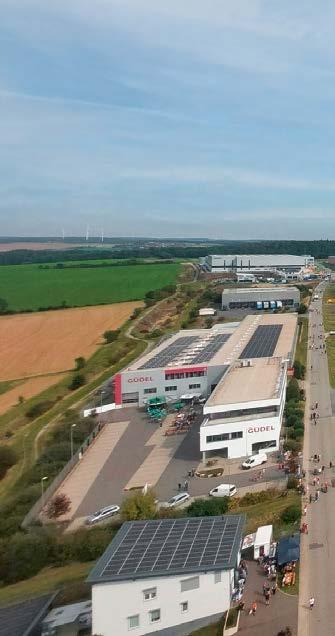
space underlines the economic attractiveness of the municipality. The development of the area has been completed and the plots are currently being marketed.
The western development axis in Ludwigshafen offers ideal locations for future-oriented companies with two new commercial areas. The “Südlich der Frankenthaler Straße” business park along Bayreuther Straße is primarily aimed at medium-sized companies. With plot sizes from 2,000 square meters, a maximum building height of 15 meters and excellent transport connections, it creates the ideal conditions for economic growth. The Mittelstandspark, which is located to the south of Mannheimer Strasse, offers around 16 hectares of high-quality commercial space for innovative companies.
VAREAL is located in the Friedrichsfeld industrial estate in Mannheim and is surrounded by production, logistics and trading companies. Thanks to its central location between Mannheim and Heidelberg, the business park offers strategically favorable connections to regional and national transport networks. The approximately 63,000 square meter site is being developed by AVENTOS into a sustainable commercial quarter with a multi-tenant
Open day at the Osterburken Regional industrial Park (Rio) to mark its 40th anniversary.
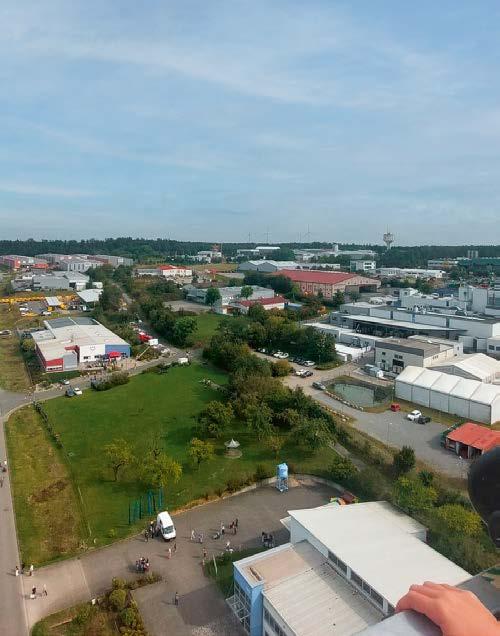
structure. A combination of preservation, revitalization and new construction will create a business park that creates modern working environments and meets high standards of sustainability and user-friendliness.
Turbinenwerk Mannheim is located in the northeast of Mannheim in the center of the Rhine-Neckar metropolitan region and is easily accessible by both public and private transport. AURELIS has redeveloped the approximately 20-hectare industrial wasteland and transformed it from a sealed factory site into an open urban quarter with a quality of stay. In addition to numerous office projects and existing halls that have already been let, a business park will be developed by 2026 for trade, manufacturing, warehousing and services. The total rental area is approx. 6,200 square meters.
Further development of commercial development areas in the Rhine-Neckar regional plan
The standardized Rhine-Neckar regional plan, which has been legally binding since 2014, forms the basis for the spatial development of the metropolitan region. In view of the increasing demand for commercial space due to company expansions, new settlements and relocations, the Rhine-Neckar Regional Association initiated the 1st amendment to
the plan chapter “Commercial development areas”. A preliminary regional commercial space study, prepared by CIMA Beratung + Management GmbH in consultation with local authorities and chambers of industry and commerce, provided important findings for this. It analyzed economic structural conditions, regional commercial space requirements and existing potential. A key result was the differentiation of regionally important commercial focal points into “priority areas for industry and logistics” and “priority areas for services and commerce”. These priority areas serve as a control instrument for regional planning by offering planning and investment security and at the same time excluding competing uses. The revision of the priority areas has increased the total area of commercial priority areas in the regional plan by approx. 235 hectares to around 2,025 hectares. The 1st amendment to the regional plan is currently being reviewed by the Baden-Württemberg Ministry for Regional Development and Housing and the approval process is expected to be completed in 2025.
Transparency for investors
The Rhine-Neckar commercial real estate portal offers tradespeople and investors a comprehensive overview of available commercial properties in the region. With a user-friendly search function, properties can be filtered according to size, facilities, price and location. In addition, interested parties receive important information on transport connections, price and tax structure as well as direct contact details of the space providers. The portal thus makes a significant contribution to the transparency of the Rhine-Neckar region and facilitates well-founded investment decisions.
The commercial real estate portal can be reached at www.standorte-rhein-neckar.de
Rent levels and turnover back in balance
The high level of investment reflects the opportunities for the location, with prime rents stabilizing above the national average.
At 38.5 percent, retail properties are the strongest segment on the regional investment market for the first time. Several major deals add up to 230 million euros, including Galeria am Paradeplatz in Mannheim and parts of the Darmstädter Hof-Center in Heidelberg. After years of uncertainty, the last four Galeria locations in the region in Mannheim, Heidelberg, Speyer and the Rhein-Neckar-Zentrum Viernheim have been retained and have clear prospects for the future. Prime rents have remained stable at 100 euros per square meter compared to the previous year, after falling from 2020 to 2023. Rents in Mannheim and Heidelberg are now on a par, as the decline in Heidelberg has been less pronounced. Footfall across Germany rose by around 1.5 percent in 2024, with the main street in Heidelberg being one of the winners with an increase of over 5 percent. According to Hystreet, the average footfall
Although experience and enjoyment are becoming more important for city center visitors, brick-and-mortar retail has once again won back share from online retail.
on Saturdays in April and May 2024 was around 57,000 passers-by on Mannheim’s Planken and around 66,000 on Heidelberg’s Hauptstraße. Sales have also recovered slightly: bricks-and-
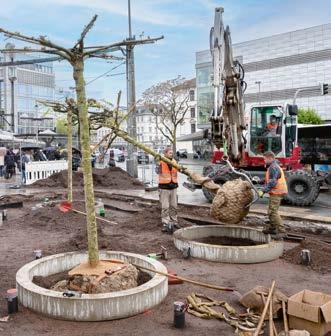
40 years after its inauguration, Bismarckplatz in Heidelberg is being modernized and upgraded. This was made possible thanks to funding from the federal program “Sustainable inner cities and centers”.
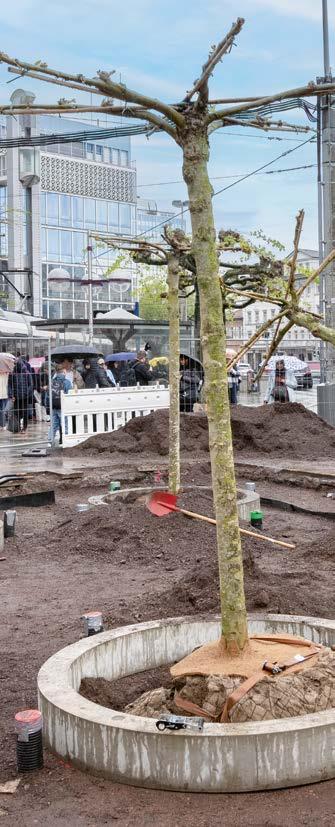
mortar retail in the region recorded an increase in sales of 4.6 percent, reaching a total volume of 8 billion euros in the Rhine-Neckar CCI district. In addition to the increase in purchasing power, a shift in the proportion of online retail to bricksand-mortar retail is also contributing to this. At 6,774 euros, per capita sales are above the average for Baden-Württemberg (6,580 euros) and Germany (6,578 euros), which indicates higher purchasing power in the region.
Heidelberg’s main street in a state of constant change
Numerous properties along Heidelberg’s central shopping street are being modernized as part of refurbishment measures, taking into account current regulations and monument protection requirements. In addition to the retail areas, the residential and office spaces above are often also be-
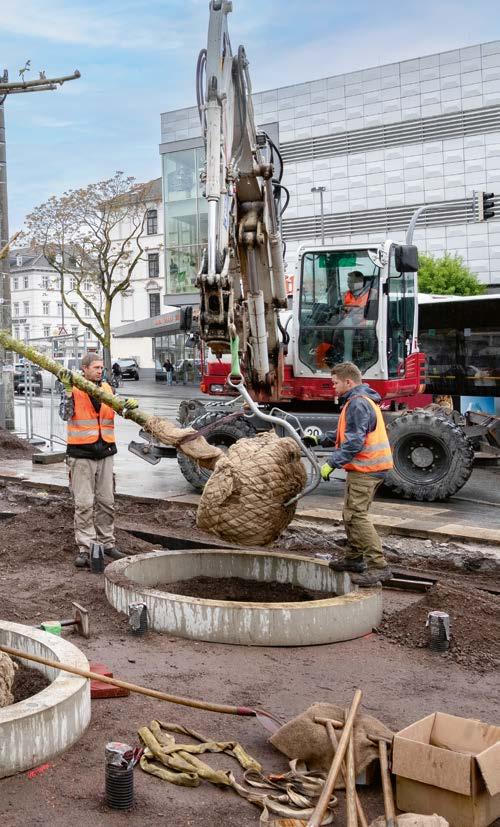
ing renovated. A master painter specializing in the renovation of old buildings also took advantage of this development and moved into the premises of a former pharmacy. The upgrades contribute to the attractiveness of the 1.6 km long pedestrian zone and ensure that the tenant mix is continuously adjusted. Rents for retailers have fallen only moderately in recent years. In 1a locations, the rent for smaller retail space fell by 5 percent to 104 euros per square meter, while larger retailers pay 71 euros per square meter (2023: 75 euros per square meter). Prime rents in 1b locations remained largely stable (–3 percent).
A new REWE store was opened in Darmstädter-Hof-Centrum. In the gastronomy sector, the opening of L’Osteria brought a new provider of Italian system gastronomy to the city center. The Galeria Kaufhof store in Hauptstraße recorded
Development of prime rents for retail properties
Source: MRN’s own representation based on data from JLL SE 202120232024 2014201520162017201820192020
Mannheim Heidelberg Bundesdurchschnitt *
customer footfall at the 2020 level again in the 2024 Advent season. A Media Markt Smart Store was one of the first four stores in Germany to open in Heidelberg, establishing a new retail concept in the pedestrian zones. In addition, an interim tenant was found for the former Schlemmermeyer store in the form of the Italian restaurant “Rossini” while the building undergoes extensive refurbishment. The fashion label Only has expanded, creating space for Only & Sons in its former location on the main street. The traditional coffee roasting company Jansen has been given a new branch, which is currently being renovated. “Von Lennox” ladies’ fashion has “improved” from Sofienstraße to Hauptstraße. Diagonally opposite, “Oranje Blumen” from Bismarckplatz, also enlarged, moved in at the end of 2024.
City center development from the old town to the main train station
Under the title “MITTENDRINNENSTADT”, the city center from the old town via Bergheim to the main train station will be strengthened by the end of 2025 with a funding program of five million euros. The city is investing 1.25 million euros of this from its own funds. It will receive a further 3.75
Prime rent 2024: 100 €/m², Germany total: 92.55 €/m²
Development 2014 – 2024: –16.7%, Germany total: –18.7%
Pedestrian zone prime location
Source: JLL SE; Map: VRRN
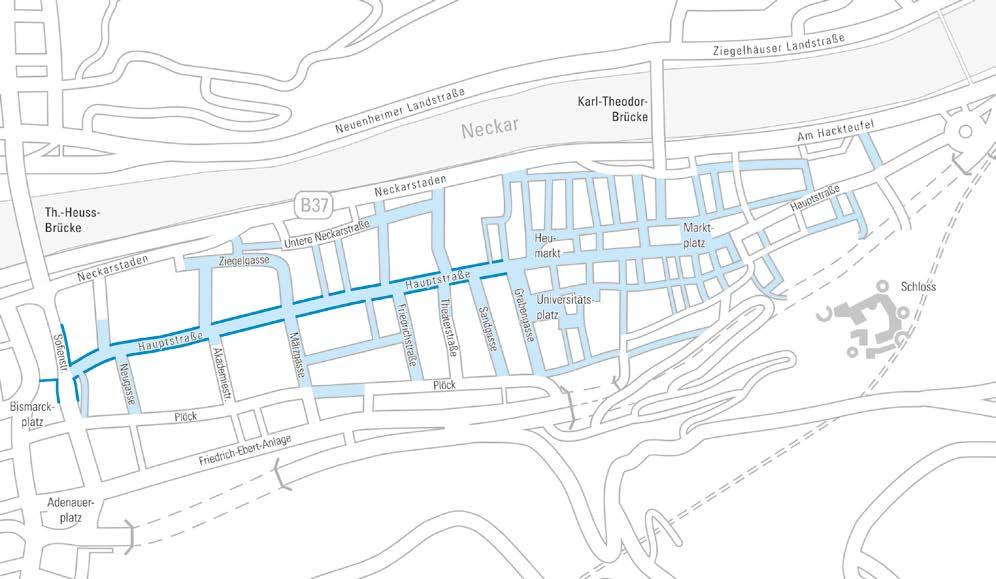
million euros in federal funding from the Ministry of Housing, Urban Development and Construction’s “Sustainable inner cities and centers” programme. Due to its prominent location, Bismarckplatz plays a key role in the further development of the city center: as part of the redesign of the
central public transport hub, new seating was created, trees planted and green spaces upgraded, barriers removed and an additional 40 bicycle parking spaces installed. The former RNV pavilion was also modernized and repurposed. Since January 2025, it has housed a fan store for the
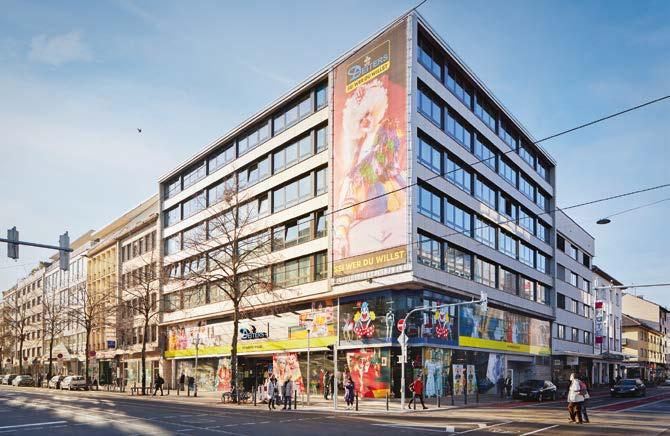
Heidelberg, Hauptstraße
In Mannheim C1, opposite the Stadthaus and Paradeplatz, the Deiters costume store opens on 1,700 square meters.
Rhein-Neckar Löwen, MLP Academics and TSG Hoffenheim as well as the Rhein-Neckar Olympic Training Center (OSP). The still vacant Galeria store on Bismarckplatz is under particular scrutiny as a central retail space. There are ongoing discussions about the possible takeover of the building, which are being actively supported by the City of Heidelberg. The city center management has set up a project office in Poststrasse as a contact point for citizen participation.
Developing Mannheim’s city center together
The city of Mannheim is focusing on strengthening, developing and transforming the city center through various measures. City-Net-Eigentümernetzwerk Innenstadt Mannheim e. V. was further expanded in 2024. The voice of investment decision-makers was strengthened with the addition of seven new members. The owners have also
Mannheim, Planken
Prime rent 2024: 100 €/m²,, Germany total: 92.55 €/m²
Development 2014 – 2024: –41.2%, Germany total: –18.7%
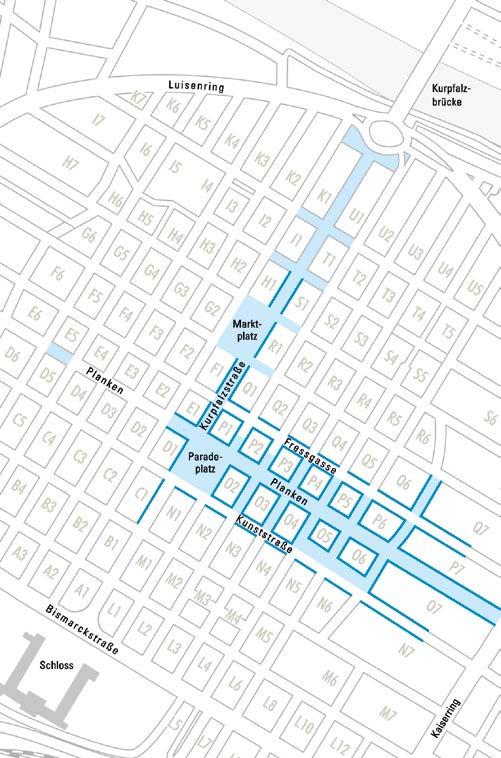
developed their own charter in which they have set out their positions and responsibilities. The Economic Development Agency actively supports the network by taking over the office.
The question of the future viability of city centers is a nationwide issue, and various innovative approaches and measures can be tested with the help of federal funding. The city of Mannheim is participating in this program as part of the FutuRaum project. In a large, innovative participation process, the challenges associated with the task are being addressed with the involvement of the relevant stakeholders. Initially, the focus was placed on Fressgasse, the relevant stakeholders were brought together in the “City Factory” group and a target vision for Fressgasse 2028 was jointly developed. The measures include different approaches, whereby a distinction can be made between activating measures (e.g. events, street music), advisory measures (e.g. outdoor advertising systems) and structural measures (e.g. street design).
Investments and new openings
The redesign of the Planken was completed in November 2024. After the main axis, which was already modernized in spring 2019, the side streets also received a comprehensive upgrade. The city of Mannheim and MVV Netze GmbH invested around 10.3 million euros to create an attractive cityscape with high-quality surfacing and modern furnishings. Last but not least, the platforms at the Paradeplatz stop between Paradeplatz and D1 were also upgraded to make them handicapped accessible and the tracks were replaced. In addition, the road surface of an entire quadrant in the eastern part of Oberstadt was renewed with thin-layer cold asphalt renovation.
Despite the overall economic challenges, several new openings were recorded in Mannheim city center in 2024. Deiters, a specialist store for costumes and party supplies, opened a 1,700 square meter store on three floors at Paradeplatz (formerly Thalia). Walbusch, which originally specialized in mail order, has opened a bricks-and-mortar store for men’s and women’s fashion on the Planken. The shoe retailer Gabor also expanded its branch network with a new location. Thalia in P7 was completely modernized, with the product range being expanded, particularly in the toys
Pedestrian zone prime location
Source: JLL SE; Map: VRRN
Ludwigshafen, Ludwigstraße
Pedestrian zone prime location Map: VRRN
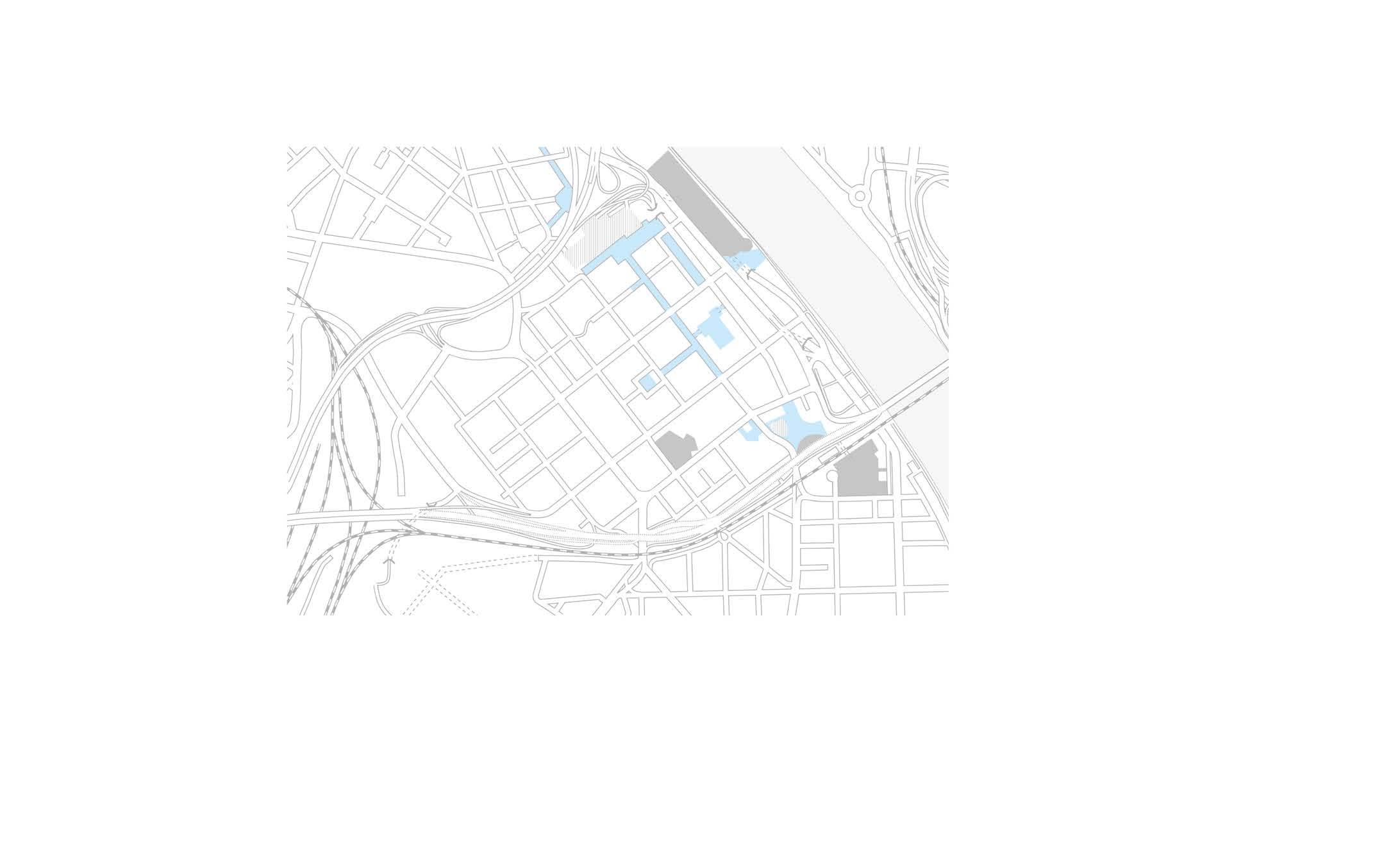
family opened in Mutterstadt at the end of 2024. row of stores in the checkout area with various
SANIERUNG
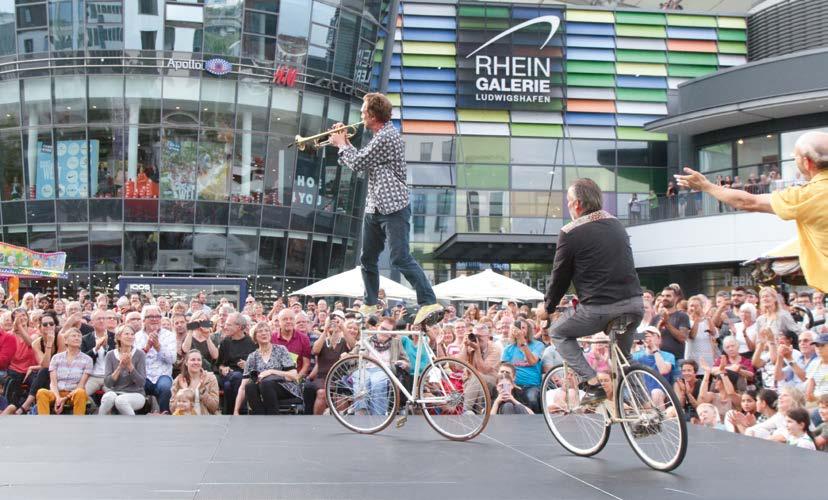

Source: GfK GeoMarketing (key figures as at 2024), Federal Statistical Office (population as at 31.12.2023)
(Umbau)
The Platz der deutschen Einheit in front of the Rhein-Galerie is now the first address for openair events in Ludwigshafen, such as the street theater festival or the Rheinuferfest.
Return-to-Office Analysis
Rhine-Neckar
The amount of time employees spend in the office is an important parameter for employers when planning their future utilization concepts and space requirements for office properties.
Methodology of the study
The “Return to Office – Rhine-Neckar Metropolitan Region” study conducted by JLL Research in January and February 2025 analyzes the current usage behavior of office space in Heidelberg, Ludwigshafen and Mannheim. The study is based on an online survey of 975 office employees in the aforementioned cities.
Occupancy rate of the three largest cities in the metropolitan region
Number of office days per week
The study conducted by JLL Research analyzes the current usage behavior of office space in Heidelberg, Ludwigshafen and Mannheim based on an online survey of employees. The aim was to determine the return-to-office rate (RTO) and to examine differences in terms of sectors, company size and accessibility of offices.
Occupancy rate and office days – positive trend, but not yet at pre-pandemic level
The average office occupancy rate in Heidelberg, Ludwigshafen and Mannheim is currently 76 percent, compared to 85 percent before the coronavirus pandemic. Respondents are in the office an average of 3.8 days per week, compared to 4.2 days before the pandemic. Heidelberg has the highest attendance at 4.0 days per week, followed by Mannheim and Ludwigshafen with 3.7 days each. Despite the increase in office presence, the level remains below the pre-corona level. This regional trend reflects the nationwide increase in office occupancy, which reached an average of 72 percent in the seven largest German cities (Big 7) in 2024, compared to 63 percent in the previous year and 79 percent before the pandemic.
Industries and company sizes –smaller companies and certain industries are driving the return
The return to the office varies depending on the industry and company size. Office presence has almost returned to pre-pandemic levels, particularly in the construction, real estate and housing sectors and in public administration. Smaller companies with up to 49 employees have a return rate of 98 percent,
How many days in a typical working week are you currently in the office? How many days were you in the office in a typical working week before the coronavirus pandemic (March 2020)?
while larger companies with more than 250 employees have a rate of 77 percent. These regional observations are in line with national trends, where companies with fewer than ten employees have a return rate of 96 percent.
Company guidelines – clear guidelines promote office presence
Company guidelines play a decisive role in the return to the office. Clear and binding attendance guidelines lead to a higher presence, while flexible regulations tend to lead to more home office use. The study shows that employees in companies with fixed attendance obligations return to the office more frequently than those with a free choice of work location. This trend can also be observed nationwide, where 87 percent of employers expect their employees to work in the office at least some of the time and 33 percent have introduced a presence requirement. However, employees with freedom of choice are also returning to the office. Respondents who describe their company’s attendance policy as “completely flexible” are currently in the office for an average of 3.2 working days per typical working week. Before corona, it was 3.9 days.
Demographic differences – age and family situation have little impact on office presence
The analysis shows that demographic factors such as age and family situation only have a minor impact on office presence. Although employees with children are in the office slightly less often, they have a return rate comparable to that of their colleagues without children. The age of the employees also plays a subordinate role, which indicates that structural framework conditions such as company guidelines and accessibility of the workplace are more decisive. These findings are in line with nationwide observations, which show that employees with a management function are in the office slightly more often overall than those without man-
Office days according to attendance regulations in the company
On
office?
2020)?
Assessment of the accessibility of the individual office location in Rhine-Neckar (HD, LU, MA) and main modes of transport
As at: February 2025; source: JLL Research; basis: survey of 975 office workers in Heidelberg, Ludwigshafen and Mannheim in January & February 2025
agement responsibility (3.7 days compared to 3.5 days per week).
Accessibility and means of transport – the commute to work has a significant influence on office presence
The choice of means of transport and the duration of the commute have a significant influence on office presence. In Ludwigshafen, the car dominates as a means of transportation, while in Heidelberg, public transport and bicycles play a greater role. Employees with a journey time of up to 15 minutes are present in the office on average 4.02 days per week, while attendance drops to 2.78 days with a journey time of more than 60 minutes. This regional trend is also reflected in the national trend, which shows that the shorter the individual journey to the office, the greater the number of office days.
Conclusion – increasing office presence with potential for further development
The study shows that although office presence in the Rhine-Neckar metropolitan region has fallen compared to the pre-corona period, it is increasing significantly again. Factors such as company guidelines, accessibility of the workplace and company size play a decisive role here. While smaller companies have almost completely returned to working from home, working from home remains an integral part of everyday working life in larger organizations. This regional trend is in line with nationwide developments, which show a progressive return to the office. Despite this positive trend, a full return to pre-crisis levels has not yet been achieved, which points to the need for further adjustments and flexible working models.
Main means of transportation used to get to the office in the city
Office
days per typical working week
Heidelberg
Ludwigshafen
Mannheim
Sponsors
Legal information and disclaimer
Any publication, reproduction or distribution of this report, including individual parts thereof, requires the prior written consent of metropolregion Rhein-neckar gmbh the assessments in this report are subject to the following reservations: We accept no liability for losses, costs or other damages resulting from the use of the published information. The information is based on sources that we consider to be reliable. Nevertheless, we cannot guarantee that this information is correct and complete. The estimates given are based on the situation at the time of going to press (march 31, 2025). actual developments may differ significantly from the forecasts and expectations contained in this report. The publishers assume no obligation to update the statements made. The information contained herein is for general information purposes only and is not a substitute for advice.
Imprint
Published by Metropolregion Rhein-Neckar GmbH, m 1, 4– 5, 68161 mannheim, Phone 0621 10708 - 0, gmbh@m-r-n.com, www.m-r-n.com
Cartography
verband Region Rhein-Neckar, m 1, 4–5, 68161 mannheim, Phone 0621 10708 - 0, info@vrrn.de, www.m-r-n.com/verband
Layout and typesetting
Publik. Agentur für Kommunikation GmbH, Mannheim, www.agentur-publik.de
Printing
ABT Print und Medien GmbH, Bruchsaler Straße 5, 69469 Weinheim
Picture credits
DiRingeR & scheiDel group / Johannes Vogt (p. 1), mRn gmbh (pp. 2, 7, 8, 14, 27, 30), heidelberger Druckmaschinen ag (p. 2), DiRingeR & scheiDel group / Blocher Partners (p. 3), BetRieBsWeRk heidelberg (p. 3), city of mannheim / Daniel lukac (pp. 3, 29), Roche Diagnostics gmbh (p. 4), h2 moBilit Y (p. 6), Florian h hensel grundbesitz gmbh (p. 10), mWsP / Johannes Vogt (p. 13), allesWirdgut (p. 16), treehouse studios / Robin heller (altar fold p. 20), W.e g ludwigshafen / torsten kleb (p. 33)
Print run
1,500 copies
Editorial deadline March 31, 2025
available as a free PDF download and as a print version at www.m-r-n.com/publikationen




info@m-r-n.com
www.m-r-n.com/immobiliennetzwerk-rhein-neckar
